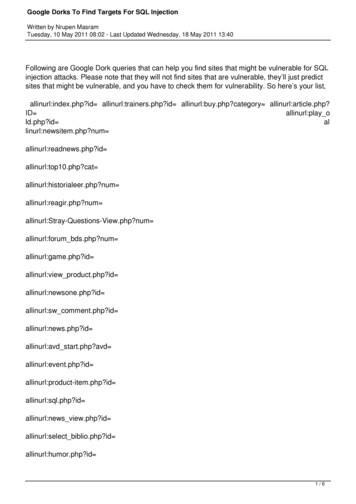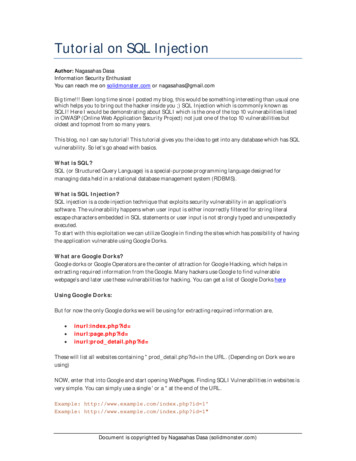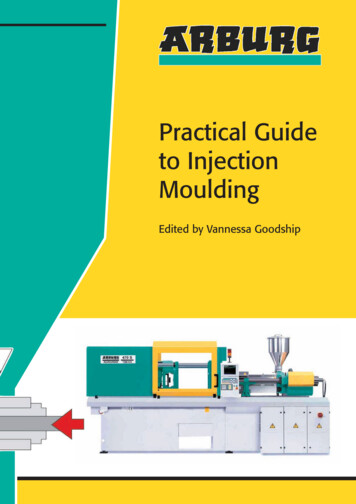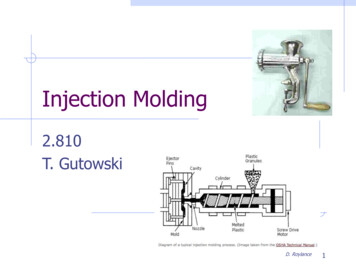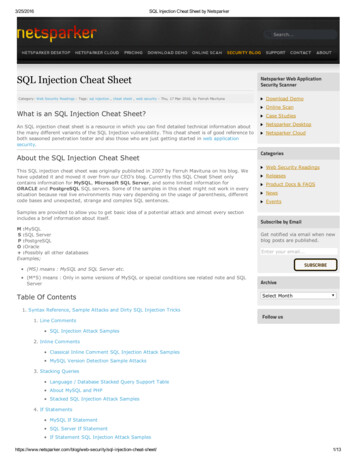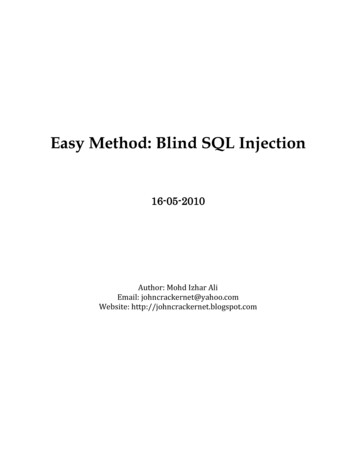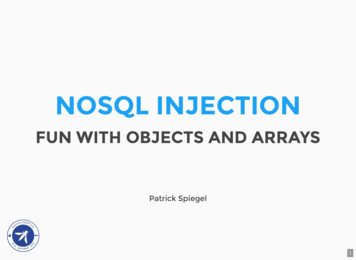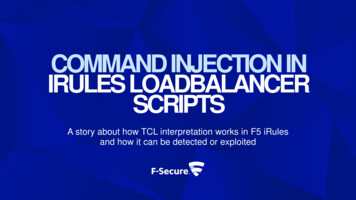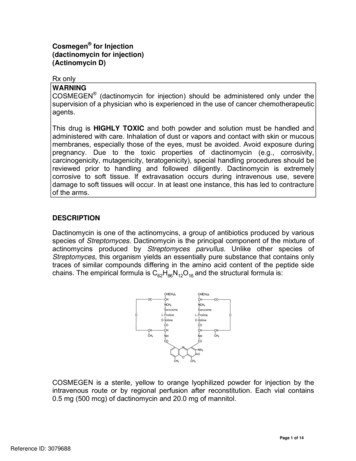
Transcription
Cosmegen for Injection(dactinomycin for injection)(Actinomycin D)Rx onlyWARNINGCOSMEGEN (dactinomycin for injection) should be administered only under thesupervision of a physician who is experienced in the use of cancer chemotherapeuticagents.This drug is HIGHLY TOXIC and both powder and solution must be handled andadministered with care. Inhalation of dust or vapors and contact with skin or mucousmembranes, especially those of the eyes, must be avoided. Avoid exposure duringpregnancy. Due to the toxic properties of dactinomycin (e.g., corrosivity,carcinogenicity, mutagenicity, teratogenicity), special handling procedures should bereviewed prior to handling and followed diligently. Dactinomycin is extremelycorrosive to soft tissue. If extravasation occurs during intravenous use, severedamage to soft tissues will occur. In at least one instance, this has led to contractureof the arms.DESCRIPTIONDactinomycin is one of the actinomycins, a group of antibiotics produced by variousspecies of Streptomyces. Dactinomycin is the principal component of the mixture ofactinomycins produced by Streptomyces parvullus. Unlike other species ofStreptomyces, this organism yields an essentially pure substance that contains onlytraces of similar compounds differing in the amino acid content of the peptide sidechains. The empirical formula is C62H86N12O16 and the structural formula is:COSMEGEN is a sterile, yellow to orange lyophilized powder for injection by theintravenous route or by regional perfusion after reconstitution. Each vial contains0.5 mg (500 mcg) of dactinomycin and 20.0 mg of mannitol.Page 1 of 14Reference ID: 3079688
CLINICAL PHARMACOLOGYAction: Generally, the actinomycins exert an inhibitory effect on gram-positive andgram-negative bacteria and on some fungi. However, the toxic properties of theactinomycins (including dactinomycin) in relation to antibacterial activity are such asto preclude their use as antibiotics in the treatment of infectious diseases.Because the actinomycins are cytotoxic, they have an antineoplastic effect whichhas been demonstrated in experimental animals with various types of tumorimplants. This cytotoxic action is the basis for their use in the treatment of certaintypes of cancer. Dactinomycin is believed to produce its cytotoxic effects by bindingDNA and inhibiting RNA synthesis.Pharmacokinetics and Metabolism: Results of a study in patients with malignant3melanoma indicate that dactinomycin ( H actinomycin D) is minimally metabolized, isconcentrated in nucleated cells, and does not penetrate the blood-brain barrier.Approximately 30% of the dose was recovered in urine and feces in one week. Theterminal plasma half-life for radioactivity was approximately 36 hours.CLINICAL STUDIESA wide variety of single agent and combination chemotherapy regimens withCOSMEGEN have been studied. Because chemotherapeutic regimens areconstantly changing, the decision to employ COSMEGEN should be directlysupervised by physicians familiar with current oncologic practices and new advancesin therapy.Wilms' Tumor: The neoplasm responding most frequently to COSMEGEN isWilms' tumor. Data from the National Wilms’ Tumor Studies (NWTS-1, NWTS-2,NWTS-3 and NWTS-4) support the use of COSMEGEN in Wilms’ tumor. TheNWTS-3 evaluated results in 1,439 patients randomized to various regimensincorporating COSMEGEN (see table below).Page 2 of 14Reference ID: 3079688
StageThe Third National Wilms’ Tumor Study4-Year RelapseRegimenFree Survival (%)I (favorable histology)II (favorable histology)III (favorable histology)IV (favorable histology)I-III (unfavorable histology)IV (unfavorable histology)L EE DD DD1 DD2 DD-RT K K1 K2 J 2.94-YearOverallSurvival 668.368.458.352.3COSMEGEN and vincristine (10 weeks)COSMEGEN and vincristine (26 weeks)COSMEGEN, doxorubicin, and vincristine (65 weeks)COSMEGEN, doxorubicin, and vincristine (65 weeks) preceded by radiationtherapy (1000 rads)COSMEGEN, doxorubicin, and vincristine (65 weeks) preceded by radiationtherapy (2000 rads)COSMEGEN, doxorubicin, and vincristine (65 weeks) preceded by radiationtherapy (dose according to age)COSMEGEN and vincristine (65 weeks)COSMEGEN and vincristine (65 weeks) preceded by radiation therapy(1000 rads)COSMEGEN and vincristine (65 weeks) preceded by radiation therapy(2000 rads)COSMEGEN, doxorubicin, cyclophosphamide, and vincristine (65 weeks)It should be noted that the complete results from NWTS-4 have not yet beenpublished. Changes in NWTS-4 and NWTS-5 have consisted of alterations induration as well as dose intensity of COSMEGEN. As a consequence, appropriateconsultation with physicians experienced in the management of Wilms’ tumor shouldbe sought.Childhood Rhabdomyosarcoma: The Third Intergroup Rhabdomyosarcoma Study(IRS-III) studied 1,062 previously untreated pediatric patients and young adults ( 21years of age) and compared outcomes amongst a number of treatment regimens.COSMEGEN was included in all arms as a standard component of the treatmentregimen; thus, comparative data are not available from this study. Nevertheless, itdoes provide information on treatment outcomes in a large group of closely studiedpatients. For treatment purposes, patients were stratified according to clinical group,Page 3 of 14Reference ID: 3079688
histologic subtype, and site of disease. Patients in most strata were randomized, butclinical group I patients with favorable histology were not randomized and treatedaccording to a single regimen.The Third Intergroup Rhabdomyosarcoma StudyGroupNumber of ArmsChemotherapy excluding orbit,head andparatesticularsites)III(excludingspecial pelvic,orbit, scalp,parotid, oralcavity, larynx,oropharynx andcheek)IV(all)1(non-randomized)2 (randomized)cyclic sequential VA (1 year)5-YearProgressionFreeSurvival (%)(mean SEM)83 3VA, doxorubicin and RT (1 year)VA and RT (1 year)77 656 1089 554 13pulsed VAC and RT (2 years)pulsed VADRC-VAC, CDDP and RT(2 years)pulsed VADRC-VAC, CDDP, VP-16and RT (2 years)70 662 570 663 556 464 5pulsed VAC and RT (2 years)pulsed VADRC-VAC, CDDP and RT(2 years)pulsed VADRC-VAC, CDDP, VP-16and RT (2 years)27 827 827 631 630 629 7VA VADRC VAC CDDP VP-16 RT 3 (randomized)3 (randomized)5-YearOverallSurvival (%)(mean SEM)93 splatinEtoposideradiation therapyMetastatic Nonseminomatous Testicular Cancer: Combinations of vinblastine,cyclophosphamide, COSMEGEN, bleomycin and cisplatin (VAB-6 regimen) havebeen employed in the treatment of metastatic nonseminomatous testicular cancer. Ina retrospective analysis of 142 evaluable patients with primary advanced stage II orclinical stage III testicular cancer 112 (79%) achieved a complete response (CR)after treatment with VAB-6 alone or in combination with surgery. Relapses wereuncommon (12%) and 117 of 166 patients (71%) were categorized as alive withoutevidence of disease during the four years covered by the study.Page 4 of 14Reference ID: 3079688
Ewing’s Sarcoma: COSMEGEN in conjunction with vincristine, doxorubicin,cyclophosphamide and radiotherapy has been used in the management of bothmetastatic and non-metastatic Ewing’s sarcoma. Of 120 previously untreatedpatients with non-metastatic disease treated with COSMEGEN as part ofmaintenance therapy in the United Kingdom Children’s Cancer Study Group Ewing’sTumor Study (ET-1), 49 (41%) were free of disease at 5 years and 53 (44%) werealive at 5 years. Outcomes in regional and metastatic disease for previouslyuntreated patients administered COSMEGEN resulted in 31 of 44 patients (70%)achieving a CR after a median time on study of 83 weeks. Eight of 44 (18%) patientsachieved a partial response (PR) and the remaining 5 (11%) demonstrated noresponse to the regimen.Gestational Trophoblastic Neoplasia: Single agent COSMEGEN has been usedin the management of nonmetastatic gestational trophoblastic neoplasia. In a seriesof 31 patients with nonmetastatic disease, complete and sustained remissions wereachieved with COSMEGEN alone in 94% of treated patients. Alternatingcombination regimens incorporating COSMEGEN in conjunction with etoposide,methotrexate, vincristine and cyclophosphamide (EMA-CO regimen) have also beenused in the treatment of poor prognosis gestational trophoblastic neoplasia.Administration of EMA-CO to 148 women with poor prognosis gestationaltrophoblastic neoplasia resulted in 110 (80%) complete and 25 (18%) partialresponses after a mean follow-up of 50.4 months. Overall survival during the studyperiod was 85% and relapses were uncommon (5.4%). Meticulous monitoring ofbeta-hCG (human chorionic gonadotropin) must be incorporated into the treatmentregimen.Regional Perfusion in Locally Recurrent and Locoregional Solid Malignancies:COSMEGEN, as a component of regional perfusion, has been administered aspalliative treatment and as an adjunct to tumor resection in the management oflocally recurrent and locoregional sarcomas, carcinomas and adenocarcinomas.INDICATIONS AND USAGECOSMEGEN, as part of a combination chemotherapy and/or multi-modalitytreatment regimen, is indicated for the treatment of Wilms’ tumor, childhoodrhabdomyosarcoma, Ewing’s sarcoma and metastatic, nonseminomatous testicularcancer.COSMEGEN is indicated as a single agent, or as part of a combinationchemotherapy regimen, for the treatment of gestational trophoblastic neoplasia.COSMEGEN, as a component of regional perfusion, is indicated for the palliativeand/or adjunctive treatment of locally recurrent or locoregional solid malignancies.Page 5 of 14Reference ID: 3079688
CONTRAINDICATIONSHypersensitivity to any component of this product.COSMEGEN should not be given at or about the time of infection with chickenpox orherpes zoster because of the risk of severe generalized disease which may result indeath.WARNINGSReports indicate an increased incidence of second primary tumors (includingleukemia) following treatment with radiation and antineoplastic agents, such asCOSMEGEN. Multi-modal therapy creates the need for careful, long-termobservation of cancer survivors.Pregnancy Category D: COSMEGEN may cause fetal harm when administered toa pregnant woman. COSMEGEN has been shown to cause malformations andembryotoxicity in rat, rabbit, and hamster when given in doses of 50-100 mcg/kg(approximately 0.5 - 2 times the maximum recommended daily human dose on abody surface area basis). If this drug is used during pregnancy, or if the patientbecomes pregnant while receiving this drug, the patient should be apprised of thepotential hazard to the fetus. Women of childbearing potential must be warned toavoid becoming pregnant.PRECAUTIONSGeneral: This drug is HIGHLY TOXIC and both powder and solution must behandled and administered with care (see boxed warning and HOW SUPPLIED,Special Handling). Since COSMEGEN is extremely corrosive to soft tissues, it isintended for intravenous use. Inhalation of dust or vapors and contact with skin ormucous membranes, especially those of the eyes, must be avoided. Appropriateprotective equipment should be worn when handling COSMEGEN. Shouldaccidental eye contact occur, copious irrigation for at least 15 minutes with water,normal saline or a balanced salt ophthalmic irrigating solution should be institutedimmediately, followed by prompt ophthalmologic consultation. Should accidental skincontact occur, the affected part must be irrigated immediately with copious amountsof water for at least 15 minutes while removing contaminated clothing and shoes.Medical attention should be sought immediately. Contaminated clothing should bedestroyed and shoes cleaned thoroughly before reuse (see HOW SUPPLIED,Special Handling).As with all antineoplastic agents, COSMEGEN is a toxic drug and very careful andfrequent observation of the patient for adverse reactions is necessary. Thesereactions may involve any tissue of the body, most commonly the hematopoieticsystem resulting in myelosuppression. As such, live virus vaccines should not bePage 6 of 14Reference ID: 3079688
administered during therapy with COSMEGEN. The possibility of an anaphylactoidreaction should be borne in mind.It is extremely important to observe the patient daily for toxic side effects whencombination chemotherapy is employed, since a full course of therapy occasionallyis not tolerated. If stomatitis, diarrhea, or severe hematopoietic depression appearduring therapy, these drugs should be discontinued until the patient has recovered.Veno-occlusive Disease: Veno-occlusive disease (primarily hepatic) may result infatality, particularly in children younger than 48 months.(See ADVERSEREACTIONS, Hepatic.)COSMEGEN (dactinomycin for injection) and Radiation Therapy: An increasedincidence of gastrointestinal toxicity and marrow suppression has been reported withcombined therapy incorporating COSMEGEN and radiation. Moreover, the normalskin, as well as the buccal and pharyngeal mucosa, may show early erythema. Asmaller than usual radiation dose administered in combination with COSMEGENcauses erythema and vesiculation, which progress more rapidly through the stagesof tanning and desquamation. Healing may occur in four to six weeks rather than twoto three months. Erythema from previous radiation therapy may be reactivated byCOSMEGEN alone, even when radiotherapy was administered many months earlier,and especially when the interval between the two forms of therapy is brief. Thispotentiation of radiation effect represents a special problem when the radiotherapyinvolves the mucous membrane. When irradiation is directed toward thenasopharynx, the combination may produce severe oropharyngeal mucositis.Severe reactions may ensue if high doses of both COSMEGEN and radiationtherapy are used or if the patient is particularly sensitive to such combined therapy.Particular caution is necessary when administering COSMEGEN within two monthsof irradiation for the treatment of right-sided Wilms' tumor, since hepatomegaly andelevated AST levels have been noted. In general, COSMEGEN should not beconcomitantly administered with radiotherapy in the treatment of Wilms’ tumorunless the benefit outweighs the risk.COSMEGEN (dactinomycin for injection) and Regional Perfusion Therapy:Complications of the perfusion technique are related mainly to the amount of drugthat escapes into the systemic circulation and may consist of hematopoieticdepression, absorption of toxic products from massive destruction of neoplastictissue, increased susceptibility to infection, impaired wound healing, and superficialulceration of the gastric mucosa. Other side effects may include edema of theextremity involved, damage to soft tissues of the perfused area, and (potentially)venous thrombosis.Laboratory Tests: Many abnormalities of renal, hepatic, and bone marrow functionhave been reported in patients with neoplastic diseases receiving COSMEGEN.Renal, hepatic, and bone marrow functions should be assessed frequently.Page 7 of 14Reference ID: 3079688
Drug/Laboratory Test Interactions: Dactinomycin may interfere with bioassayprocedures for the determination of antibacterial drug levels.Carcinogenesis, Mutagenesis, Impairment of Fertility: Reports indicate anincreased incidence of second primary tumors (including leukemia) followingtreatment with radiation and antineoplastic agents, such as COSMEGEN. Multimodal therapy creates the need for careful, long-term observation of cancersurvivors.The International Agency on Research on Cancer has judged that dactinomycin is apositive carcinogen in animals. Local sarcomas were produced in mice and rats afterrepeated subcutaneous or intraperitoneal injection. Mesenchymal tumors occurred inmale F344 rats given intraperitoneal injections of 50 mcg/kg, 2 to 5 times per weekfor 18 weeks. The first tumor appeared at 23 weeks.Dactinomycin has been shown to be mutagenic in a number of test systems in vitroand in vivo including human fibroblasts and leukocytes, and HeLa cells. DNAdamage and cytogenetic effects have been demonstrated in the mouse and the rat.Adequate fertility studies have not been reported, although, reports suggest anincreased incidence of infertility following treatment with other antineoplastic agents.Pregnancy: Pregnancy Category D(See WARNINGS.)Nursing Mothers: It is not known whether this drug is excreted in human milk.Because many drugs are excreted in human milk and because of the potential forserious adverse reactions in nursing infants from COSMEGEN, a decision should bemade as to discontinuation of nursing and/or drug, taking into account theimportance of the drug to the mother.Pediatric Use: The greater frequency of toxic effects of COSMEGEN in infantssuggest that this drug should be administered to infants only over the age of 6 to 12months.Geriatric Use: Clinical studies of COSMEGEN did not include sufficient numbers ofsubjects aged 65 and over to determine whether they respond differently fromyounger subjects. Other reported clinical experience has not identified differences inresponses between the elderly and younger patients. However, a published meta analysis of all studies performed by the Eastern Cooperative Oncology Group(ECOG) over a 13-year period suggests that administration of COSMEGEN toelderly patients may be associated with an increased risk of myelosuppressioncompared to younger patients. In general, dose selection for an elderly patientshould be cautious, usually starting at the low end of the dosing range, reflecting thegreater frequency of decreased hepatic, renal, or cardiac function, and ofconcomitant disease or other drug therapy.Page 8 of 14Reference ID: 3079688
ADVERSE REACTIONSToxic effects (excepting nausea and vomiting) usually do not become apparent untiltwo to four days after a course of therapy is stopped, and may not peak until one totwo weeks have elapsed. Deaths have been reported. However, adverse reactionsare usually reversible on discontinuance of therapy. They include the following:Miscellaneous: Sepsis (including neutropenic sepsis) with fatal outcome, infection,malaise, fatigue, lethargy, fever, myalgia, proctitis, hypocalcemia and growthretardation.Oral: cheilitis, dysphagia, esophagitis, ulcerative stomatitis, pharyngitis.Lung: pneumonitis.Gastrointestinal: anorexia, nausea, vomiting, abdominal pain, diarrhea,gastrointestinal ulceration. Nausea and vomiting, which occur early during the firstfew hours after administration, may be alleviated by the administration of antiemetics.Hepatic:liver toxicity including liver function test abnormalities, ascites,hepatomegaly, hepatitis, hepatic failure with reports of death, hepatic veno-occlusivedisease which may be associated with intravascular clotting disorder and multi-organfailure (see PRECAUTIONS, Veno-occlusive Disease).Hematologic: anemia, even to the point of aplastic anemia, agranulocytosis,leukopenia, thrombocytopenia, pancytopenia, reticulocytopenia, neutropenia, febrileneutropenia. Platelet and white cell counts should be performed frequently to detectsevere hematopoietic depression. If either count markedly decreases, the drugshould be withheld to allow marrow recovery. This often takes up to three weeks.Dermatologic: alopecia, skin eruptions, acne, erythema multiforme, flare-up oferythema or increased pigmentation of previously irradiated skin. Toxic EpidermalNecrolysis (TEN) and Stevens Johnson Syndrome (SJS) have been observed frompostmarketing experience.Soft tissues: Dactinomycin is extremely corrosive. If extravasation occurs duringintravenous use, severe damage to soft tissues will occur. In at least one instance,this has led to contracture of the arms. Epidermolysis, erythema, and edema, attimes severe, have been reported with regional limb perfusion.Lab
J COSMEGEN, doxorubicin, cyclophosphamide, and vincristine (65 weeks) It should be noted that the complete results from NWTS-4 have not yet been published. Changes in NWTS-4 and NWTS-5 have consisted of alterations in duration as
